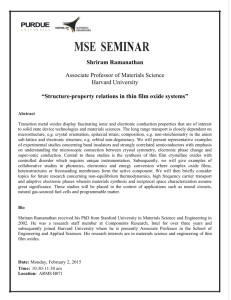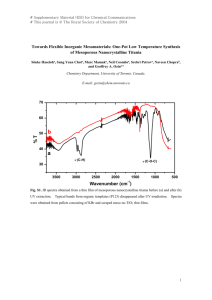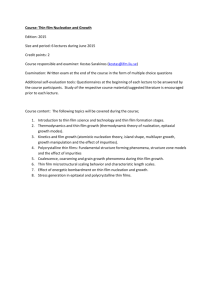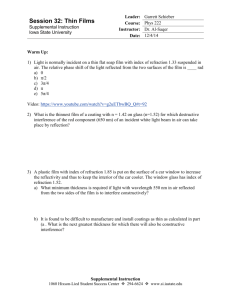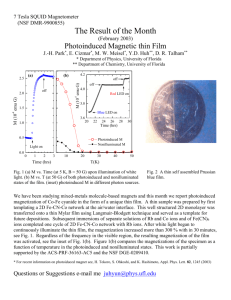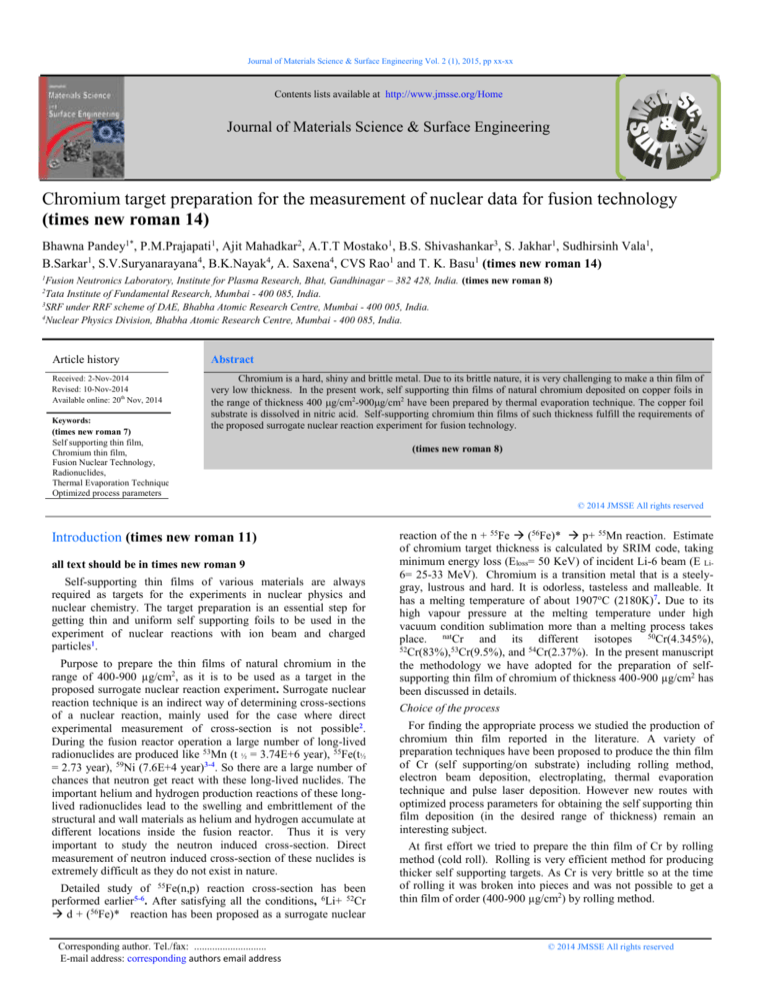
Journal of Materials Science & Surface Engineering Vol. 2 (1), 2015, pp xx-xx
Contents lists available at http://www.jmsse.org/Home
Journal of Materials Science & Surface Engineering
Chromium target preparation for the measurement of nuclear data for fusion technology
(times new roman 14)
Bhawna Pandey1*, P.M.Prajapati1, Ajit Mahadkar2, A.T.T Mostako1, B.S. Shivashankar3, S. Jakhar1, Sudhirsinh Vala1,
B.Sarkar1, S.V.Suryanarayana4, B.K.Nayak4, A. Saxena4, CVS Rao1 and T. K. Basu1 (times new roman 14)
Fusion Neutronics Laboratory, Institute for Plasma Research, Bhat, Gandhinagar – 382 428, India. (times new roman 8)
Tata Institute of Fundamental Research, Mumbai - 400 085, India.
3
SRF under RRF scheme of DAE, Bhabha Atomic Research Centre, Mumbai - 400 005, India.
4
Nuclear Physics Division, Bhabha Atomic Research Centre, Mumbai - 400 085, India.
1
2
Article history
Abstract
Received: 2-Nov-2014
Revised: 10-Nov-2014
Available online: 20th Nov, 2014
Chromium is a hard, shiny and brittle metal. Due to its brittle nature, it is very challenging to make a thin film of
very low thickness. In the present work, self supporting thin films of natural chromium deposited on copper foils in
the range of thickness 400 g/cm2-900g/cm2 have been prepared by thermal evaporation technique. The copper foil
substrate is dissolved in nitric acid. Self-supporting chromium thin films of such thickness fulfill the requirements of
the proposed surrogate nuclear reaction experiment for fusion technology.
Keywords:
(times new roman 7)
Self supporting thin film,
Chromium thin film,
Fusion Nuclear Technology,
Radionuclides,
Thermal Evaporation Technique,
Optimized process parameters
(times new roman 8)
© 2014 JMSSE All rights reserved
Introduction (times new roman 11)
all text should be in times new roman 9
Self-supporting thin films of various materials are always
required as targets for the experiments in nuclear physics and
nuclear chemistry. The target preparation is an essential step for
getting thin and uniform self supporting foils to be used in the
experiment of nuclear reactions with ion beam and charged
particles1.
Purpose to prepare the thin films of natural chromium in the
range of 400-900 µg/cm2, as it is to be used as a target in the
proposed surrogate nuclear reaction experiment. Surrogate nuclear
reaction technique is an indirect way of determining cross-sections
of a nuclear reaction, mainly used for the case where direct
experimental measurement of cross-section is not possible2.
During the fusion reactor operation a large number of long-lived
radionuclides are produced like 53Mn (t ½ = 3.74E+6 year), 55Fe(t½
= 2.73 year), 59Ni (7.6E+4 year)3-4. So there are a large number of
chances that neutron get react with these long-lived nuclides. The
important helium and hydrogen production reactions of these longlived radionuclides lead to the swelling and embrittlement of the
structural and wall materials as helium and hydrogen accumulate at
different locations inside the fusion reactor. Thus it is very
important to study the neutron induced cross-section. Direct
measurement of neutron induced cross-section of these nuclides is
extremely difficult as they do not exist in nature.
Detailed study of 55Fe(n,p) reaction cross-section has been
performed earlier5-6. After satisfying all the conditions, 6Li+ 52Cr
d + (56Fe)* reaction has been proposed as a surrogate nuclear
Corresponding author. Tel./fax: ............................
E-mail address: corresponding authors email address
reaction of the n + 55Fe (56Fe)* p+ 55Mn reaction. Estimate
of chromium target thickness is calculated by SRIM code, taking
minimum energy loss (Eloss= 50 KeV) of incident Li-6 beam (E Li6= 25-33 MeV). Chromium is a transition metal that is a steelygray, lustrous and hard. It is odorless, tasteless and malleable. It
has a melting temperature of about 1907oC (2180K)7. Due to its
high vapour pressure at the melting temperature under high
vacuum condition sublimation more than a melting process takes
place. natCr and its different isotopes 50Cr(4.345%),
52Cr(83%),53Cr(9.5%), and 54Cr(2.37%). In the present manuscript
the methodology we have adopted for the preparation of selfsupporting thin film of chromium of thickness 400-900 µg/cm2 has
been discussed in details.
Choice of the process
For finding the appropriate process we studied the production of
chromium thin film reported in the literature. A variety of
preparation techniques have been proposed to produce the thin film
of Cr (self supporting/on substrate) including rolling method,
electron beam deposition, electroplating, thermal evaporation
technique and pulse laser deposition. However new routes with
optimized process parameters for obtaining the self supporting thin
film deposition (in the desired range of thickness) remain an
interesting subject.
At first effort we tried to prepare the thin film of Cr by rolling
method (cold roll). Rolling is very efficient method for producing
thicker self supporting targets. As Cr is very brittle so at the time
of rolling it was broken into pieces and was not possible to get a
thin film of order (400-900 µg/cm2) by rolling method.
© 2014 JMSSE All rights reserved
Bhawna et al./ Chromium target preparation for the measurement of nuclear data for fusion technology
Kuehn et al.8 described the preparation of self supporting
metallic foils of several chromium isotopes by electroplating. We
have tried the thin film deposition of Cr by electroplating method.
We deposited the Cr on nickel and copper substrate. But at the time
of removal of substrate it was not possible to get a self supporting
thin film as per our requirements (400-900 µg/cm2).
Yoshiaki Uemura et al.9 discussed the preparation of various
elements thin film by electron gun (e- beam deposition) method
and achieved the self supporting thin film of 0.1-1 mg/cm2.In our
study, we also tried with e- beam deposition to get the thickness of
Cr thin film around 400-900 µg/cm2. We have deposited chromium
on the glass micro slides using Teepol and NaCl films as a release
(parting) agent. But the deposition of Cr was not uniform. We tried
to float these Cr films on the water but Cr did not separate from the
release agent.
pestle. From this powder 7.3 mgs powder was put in the tantalum
boat.
Commercially available Cu foil having a thickness of 37 microns
was cleaned, by dilute nitric acid to dissolve the impurities and
oxides present, and then by isopropyl alcohol. After that it was
cold rolled to get the thickness of 27.6 microns, which was cut into
a foil of about 30mm 30 mm. The weight of Cu foil was
221.7mg. This Cu foil was kept at a distance of 16 mm from the
top of the tantalum boat, on the aluminum mask having a hole of
25 mm diameter, kept on the brass stand. On this copper foil a
micro-glass slide was kept to avoid the curling or folding of the
Cu-foil at the time of evaporation, as shown in Fig. 4.
Birgit K. et al. 10 recently prepared thin film of isotopic 50Cr by
thermal evaporation technique, in the range of 250-620 µg/Cm2. In
our work we perform complete study of natural Cr thin film
deposition by thermal evaporation technique and got success to
achieve the desired thickness of around 400-900 µg/cm2. We have
optimized the process parameters of thermal evaporation method,
to get the desired thickness (400-900 µg/cm2) of natural Cr self
supporting thin film, which will be used as a target in the nuclear
physics experiment. The flow chart for natCr thin film synthesis in
this study is outlined in Fig.1.
Figure 2: Tantalum boat connected between copper electrodes
Figure 3: Thermal Evaporation Set-up
Figure 1: Flow chart illustrating the procedure for the preparation
of natCr thin film
Experimental
Deposition of Chromium on Cu Substrate
A Tantalum boat having diameter of 10 mm and height about 20
mm, was connected to two copper electrodes Fig.2. This assembly
was kept in the vacuum chamber and evacuated to the pressure of
about 5 10 -5 mbar. Thermal Evaporation set-up is shown in Fig.3.
Then tantalum crucible was blank heated for 3 minutes to remove
any impurities if at all present in it. After cooling the electrodes
and tantalum boat, the air was released in the chamber. 99.9% pure
chromium chunks of about 89 mgs were powdered by mortar and
JMSSE Vol. 1 (3), 2014, pp 78-80
Figure 4: Micro-glass slide on copper foil
The glass chamber was evacuated to about 5 10 -2 mbar and
argon was flushed thrice into the chamber to remove air molecules.
Then this chamber was again evacuated initially to 10 -2 mbar by
rotary pump and then to 5 10 -5 mbar by oil diffusion pump. The
current of 195-200 amp was passed through the copper electrodes
to a tantalum boat, through a transformer via VARIAC. The
© 2014 JMSSE All rights reserved
Bhawna et al./ Chromium target preparation for the measurement of nuclear data for fusion technology
heating was continued for three minutes. After 3 mins current was
stopped. The chamber was allowed to cool down for about 30
mins. Then the Cr deposited copper foil was removed and
weighed. The weight of copper foil along with deposited Cr was
224.1 mg. The increase in weight shows that 2.5 mg of Cr got
deposited on Copper foil. The total Cr deposited area was 4.9 Cm2
(as shown in Fig. 5). That is the thickness of Cr deposited was 0.9
mg/cm2.
Figure 7: (a) Sandwiched frames immersed in diluted nitric acid (b) Cu
removed from the back side (c) Cr- thin film on target holder
Figure 8: Self-supporting thin film of Chromium
Table 1: Optimized process parameters for self supporting Cr thin film
(400-900 µg/cm2)
Weight of
Cr
Powder
Thickness
of Cu Foil
Evaporat
ion time
(microns)
Distance
between
Top of a
boat and
substrate
(mm)
(mgms)
7.3
27.6
16
3
7.6
11.4
21
1
9.2
20.36
21
2
Figure 5: Chromium deposited on the copper
Dissolution of Copper
The Cr deposited Copper foil was sandwiched in between two
stainless steel target frames having area of 25 mm 18 mm and 14
mm diameter hole, (as shown in Fig.6) by the screws. These
sandwiched frames were immersed in 40 % diluted nitric acid as
shown in Fig 7. and kept it for approximate 2 mins. After 2 mins it
was observed that all the copper was dissolved and pure chromium
film was intact in between the frames.
3Cu 8HNO3 3Cu( NO3 ) 2 2 NO 4 H 2O
…….(1)
Using same procedure we have prepared 2 more Cr targets of
thickness 0.408 mgms/cm2 and 0.410mgms/cm2, as shown in Fig.
8, by varying the weight of Cr powder, thickness of Cu foil,
distance between source and substrate, evaporation time, conc. of
HNO3. Details are given in Table 1.
Conc of
HNO3
Dissolut
-ion
time
of Cu
Foil
(mins)
Thickness
of Cr
Foil per
Sq.Cm.
40%
2
0.900
20%
40
0.408
20%
75
0.410
(mins)
(mgms)
Conclusions
We have successfully prepared the natural chromium self
supporting thin film of thickness 400-900 µg/cm2 using thermal
evaporation technique. Due to very brittle nature of Cr the self
supporting thin film preparation of less than one micron is not an
easy task. In the present work we have optimized the process
parameters to obtain a stable self-supporting thin film of the
required thickness.
The natural chromium and its different isotopes are desired as a
self supporting foils (target) for nuclear research experiment, that’s
why it is very important to have a knowledge of optimized process
parameters by which we can prepare the fresh targets at the time of
nuclear physics experiment.
References
(times new roman 8)
1.
2.
3.
(a)
(b)
(c)
Figure 6: Cr deposited Copper foil, (a) sandwiched in between two
stainless steel target frame (b) front part- deposited Cr (c) back part -Cu foil
(a)
JMSSE Vol. 1 (3), 2014, pp 78-80
(b)
Anna Stolarz (2014) J Radioanal Nucl Chem 299:913–931
J.E.Escher, et al. (2012) ReV. Mod. Phys 84: 353-397.
Wallner et al. (2011) Journal of the Korean Physical Society 59:
1378-1381.
4. R.A. Forrest (2006) Fusion Engineering and Design 81: 21432156.
5. B. Pandey et al (2011) Annals of Nuclear Energy 38: 853- 859.
6. B. Pandey et al (Feb 2015) Nuclear Science and Engineering, In
press.
7. http://en.wikipedia.org/wiki/chromium
8. Kuehn PR, O’Donnel FR, Kobisk EH (1972) Nucl Instrum
Methods 102:403-407.
9. Yoshiaki Uemura et al. (1969) Bull.Inst.Chem.Res.Kyoto Univ.,
Vol. 47, No. 2.
10. Birgit Kindler et al. (2014) J Radioanal Nucl Chem 299:11411143.
(c)
© 2014 JMSSE All rights reserved

